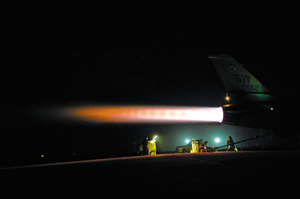In the early 1980s, engine manufacturers Pratt & Whitney and General Electric began an unusual, decade-long struggle. The goal each year was to win the largest annual share of F-15 and F-16 engine contracts from the Air Force. This became known as “the Great Engine War,” and its lessons still are debated.
The subject is hardly academic. That bygone war now shapes up as a template for a possible second conflict. This prospective contest would match up the same two engine houses, and decide how to divvy up engine contracts for the new F-35 fighter. Billions are at stake.
 |
|
P&W already is on the battlefield; years ago, its F135 engine was picked for the F-35 contract. The specific question now is this: Should the Pentagon spend scarce dollars to qualify an “alternate” engine and keep alive a competition P&W thought it had won
Under current plans, the F-35 will dominate fighter procurement for decades. By 2035, the F-35 may represent 95 percent of all manned fighter aircraft in the US inventory.
With the F-35 exerting such an enormous impact, the engine question looms large. The Defense Department itself has wavered. In mid-2005, it awarded General Electric a $2.4 billion multiyear contract for developing GE’s competitive F136 engine. Four months later, in December 2005, DOD dropped its support and declared its backing for short-term engine cost savings.
Then-Air Force Secretary Michael W. Wynne told lawmakers that he “fought to include the second engine,” but in the 2007 and 2008 budgets, yielded to DOD demands “to provide harmony in the house.”
Congress subsequently ordered three independent reviews of the alternate engine program.
DOD’s Cost Analysis Improvement Group said a competition must yield 25 percent savings to break even. The Institute for Defense Analyses determined that 40 percent savings would be needed to break even in procurement. Both the CAIG and IDA determined that the program is unlikely to save DOD money unless the long-term operations and support contracts are also competed. The Government Accountability Office found a break-even point at some 12 percent savings.
Despite pressure from Congress, the Pentagon since 2005 has refused to fund the program. Congress simply adds the money anyway and orders DOD to continue with the program. In this way, the alternate F136 engine received $465 million this year. Lt. Gen. Mark D. Shackelford, USAF’s top uniformed acquisition officer, testified in March that the alternative engine program will cost the US $4.3 billion through 2015.
President Obama himself called the alternate engine program an example of “unnecessary defense programs that do nothing to keep us safe” when he announced the details of DOD’s 2010 budget request May 8.
Yet cost is not the only consideration. In the early 1990s, P&W’s F135 was selected by both Lockheed Martin and Boeing to power their respective F-35 competitors. (The F135 is derived from P&W’s F119 engine, used by the F-22 Raptor.)
Concerned that P&W was being handed a future fighter engine monopoly, however, Congress in 1996 ordered an alternate engine program based on the GE-Rolls Royce F136. The intent is to produce two interchangeable engines that are nevertheless unique in their particulars. P&W has a three-year head start on the GE team, and is supplying engines to the earliest-model fighters.
P&W naturally opposes the government support of a competitor engine program. GE stands to benefit as it did in the 1980s when it skimmed off much of the F-15 and F-16 engine business—after P&W had won the competition. Thus, for the second time in the memories of P&W executives, the company faces the risk of seeing a competitive result overturned.
The Great Engine War may have lowered USAF’s prices at the time. However, the main goal was not cost reduction; it was to acquire engines with greater reliability. USAF got that.
Those who favor maintaining an alternate engine contend that it will reduce long-term costs, increase the contractor’s responsiveness to military needs, increase engine reliability, and protect a critical segment of the military industrial base. As advocates tell it, the second engine program provides insurance against a single-point failure that could undermine the entire F-35 fleet, and with it, most of the nation’s tactical airpower.
Opponents say cost savings are unlikely because of reduced economies of scale, dual logistics trains, and longer learning curves. They add that single-source engines for fighters are the norm, and dual designs will double the number of engine problems that inevitably arise. The opponents also point out that fleetwide engine failures are exceedingly rare.
The P&W F135 has, by all accounts, performed well. It has, however, experienced typical development problems. The fate of the alternate engine likely depends on how Congress weighs the value of insurance versus short-term cost. The impact on local jobs will also, surely, play a major role.
For its part, the program office has not taken sides. Maj. Gen. Charles R. Davis, the F-35 director, has said Congress should approve whichever engine development programs it feels are appropriate—but be certain to pay for them.
“If Congress uses [the F-35 development account] to fund this engine,” Davis explained, “we will have serious problems.”
More information: http://opencrs.com/document/RL33390/
